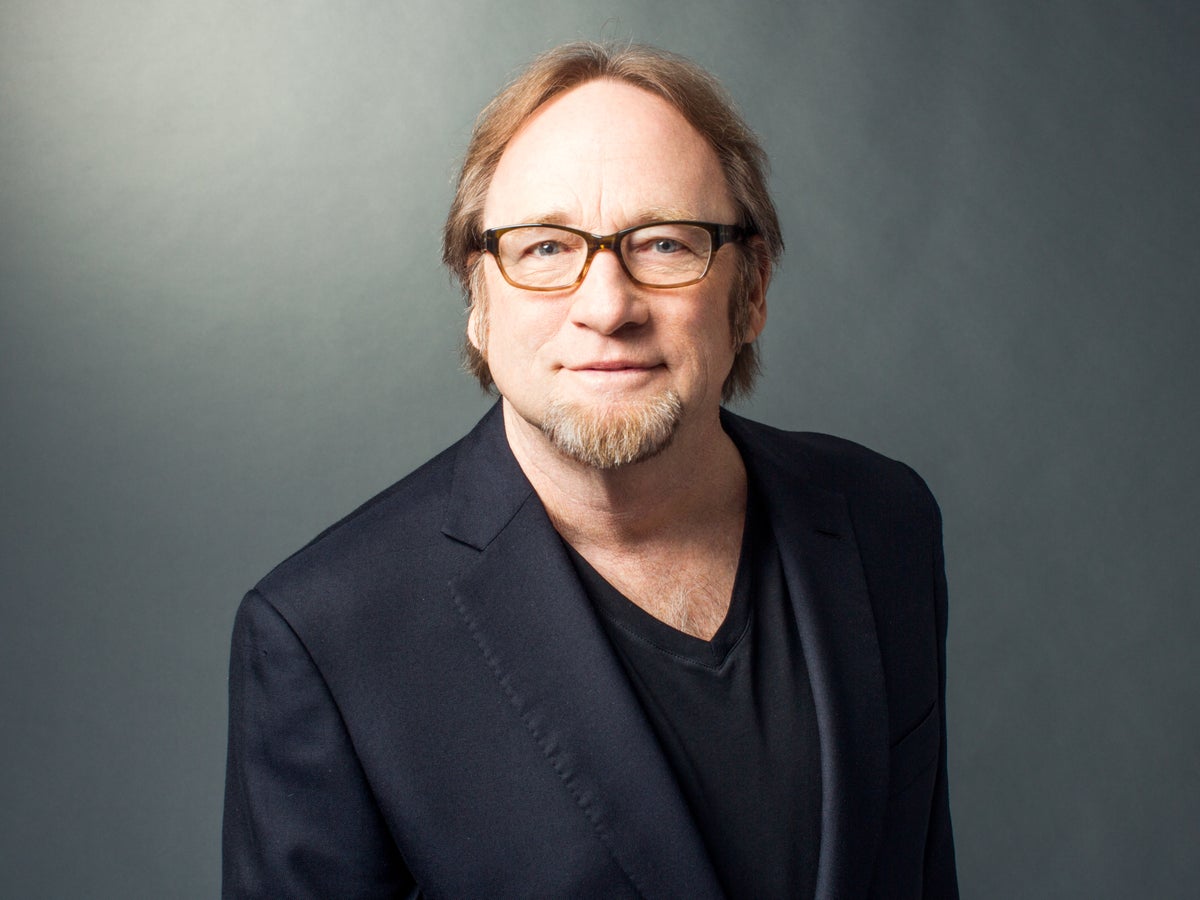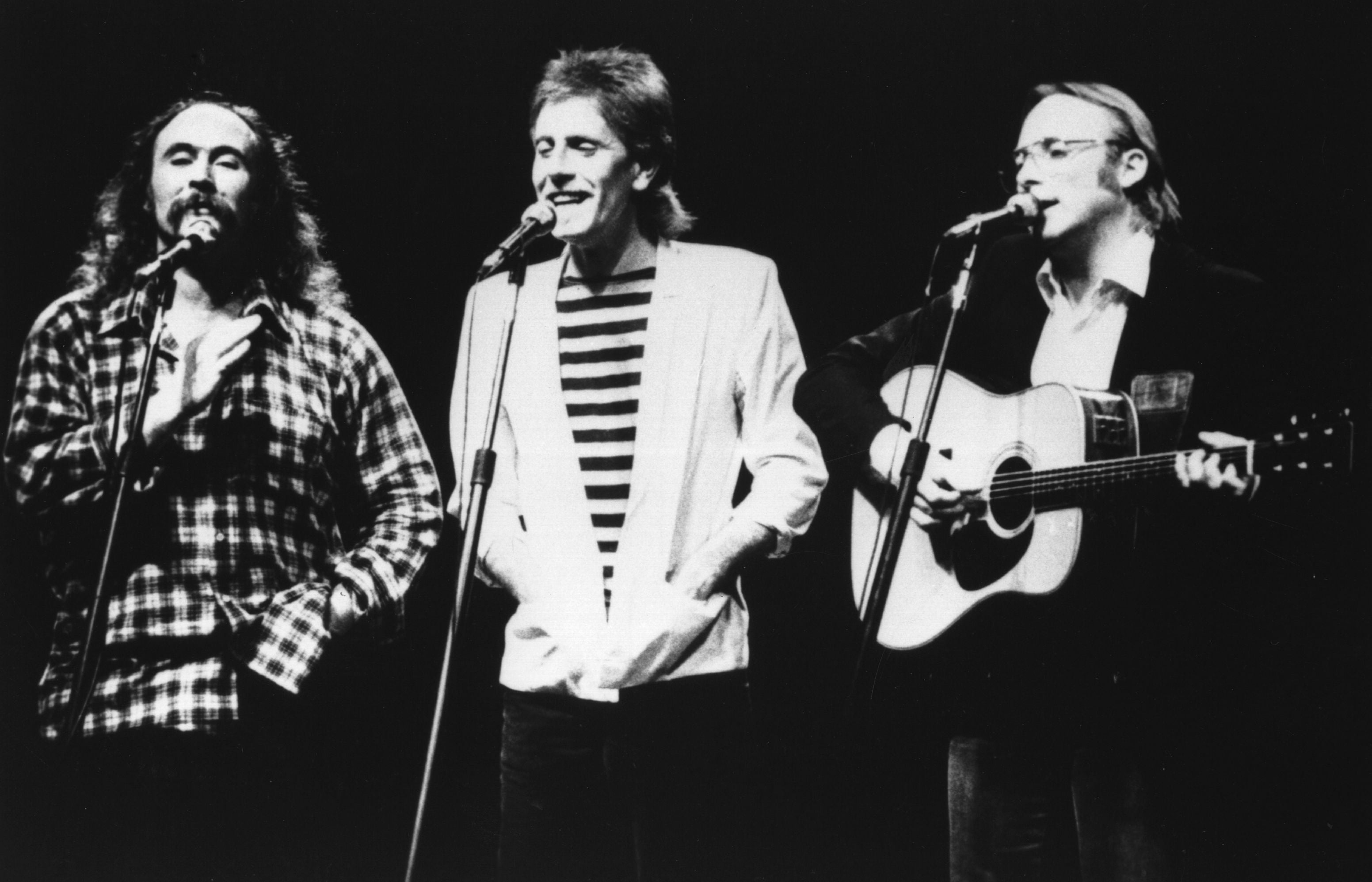
In August 1971, Stephen Stills arrived in Berkeley for the final dates of his first ever solo tour to be greeted by a surprise visitor: David Crosby. Just a year earlier their pioneering folk rock supergroup Crosby, Stills, Nash & Young had imploded in a blizzard of booze, cocaine, rampant egos and lopsided love triangles. That night, however, there were no hard feelings. “He came to see me in the dressing room before the show,” remembers Stills, who promptly invited his old friend to join him on stage. “I said: ‘Let’s do “The Lee Shore”’ and he said: ‘Alright!’ We didn’t run through it that many times – and it shows! But that’s the way we rolled back then. It was marvellous.”
Their heartfelt duet appears early on Stills’s new album Live at Berkeley 1971, which is drawn from recordings the former Buffalo Springfield guitarist recently unearthed during a deep dive into his archival vault. Now 78, Stills is speaking to me over a video call from his airy home in the hills above Los Angeles. The snowy white beard sprouting in a tuft from his chin may give him the appearance of a medieval friar but in conversation he’s mischievous and puckish, with an irreverent attitude towards his own music.
“There are some rather strange vocals,” he says of the live album, which features a solo-acoustic set followed by a full-throated electric performance backed by legendary Stax musicians the Memphis Horns. “I remind myself of… well, the term ‘barking mad’ comes to mind. We were very enthusiastic, and by the end of the shows I was literally barking because I couldn’t make the notes and everything was too fast!”
The appearance of Crosby on the album is rendered particularly poignant by the singer-songwriter’s death in January this year, at the age of 81. Stills says the news took him by surprise. “He was on his way to a last tour, and my son [Christopher] was going to play with him,” says Stills. “He just went to take a nap and didn’t wake up. Not a bad way to go, actually. There’s part of me that misses him dreadfully, and there’s part of me that thinks he got out of here just in time, if you look at the world.”
As well as Crosby’s “The Lee Shore”, on Live at Berkeley 1971 the pair also perform Stills’ composition “You Don’t Have to Cry”. The song has a special place in the mythos of Crosby, Stills and Nash as it was the first song they ever sang as a trio, although in keeping with the group’s fractious reputation there is some dispute over the details. Graham Nash says the fateful meeting happened at Joni Mitchell’s bungalow in Laurel Canyon, but Stills maintains it was actually The Mamas & the Papas’ singer Cass Elliot who gave CSN their first audience in 1968. “I remember this vividly,” he says. “She had these big fluffy pillows and couches that I sank into, so I couldn’t find a place to play guitar. The kitchen turned out to be wonderful. I sat in the corner with David on one side and Graham kind of standing around. We sang it once and he said: ‘Do that again.’ The third time he chimed in and we knew that we were done for.”
As Stills remembers things, it was the following night they repeated the trick at Joni Mitchell’s place. “I suppose because the story’s more glamorous, [Crosby and Nash] decided to superimpose that as the first time we sang it,” chuckles Stills. “That’s the story of our lives! The story of that group.” He slips into a good-natured impersonation of himself and his bickering bandmates: “‘No, I remember!’ ‘No, I remember!’”
“Watching those boys discover their blend was exciting. It was boys in love,” Mitchell recalled later. Wherever it was they first met, it didn’t take Crosby, Stills and Nash long to cement their place in musical history. They helped define the “California Sound” with the release of their self-titled debut album in 1969, with Stills contributing classic songs including “You Don’t Have to Cry”, “Helplessly Hoping” and epic opener “Suite: Judy Blue Eyes”, which was written about his imminent breakup with folk singer Judy Collins. The record has since gone platinum many times over.

Later that year, the band added Stills’s former Buffalo Springfield bandmate Neil Young to the line-up for a string of live shows, including Woodstock, before the quartet put out Déjà Vu in 1970. Cracks soon started to appear on a subsequent tour. The band who had started out in sun-kissed Laurel Canyon, wreathed in an air of pot-smoking hippy optimism, were now descending rapidly into cocaine-fuelled competitiveness and internecine squabbling. Stills, in particular, was accused of excessive control freak tendencies, and was briefly sacked from the group after playing an unscheduled extended solo set at New York’s Fillmore East when he heard Bob Dylan was in the audience.
When the group splintered, all four members released solo albums but Stills had the distinction of outselling the rest with Stephen Stills, helped by hit single “Love the One You’re With”. During the recording of the song Stills met and began a relationship with backing singer Rita Coolidge, who then left him for Nash – only compounding romantic rivalries in a group that had already seen both Crosby and Nash date Mitchell. The song’s free-love-advocating title and chorus (“If you can’t be with the one you love, honey, love the one you’re with”) was inspired by a line Stills heard keyboardist and Beatles collaborator Billy Preston say at a party. “He threw it off on the fly and I said: ‘That’d be a great song,’” remembers Stills with a nostalgic laugh. “He said: ‘Do it!’ So I did.”
Stills’s first solo album is well known among guitar aficionados for being the only record to feature both Jimi Hendrix and Eric Clapton. That piece of trivia reflects both the high esteem Stills was held in by his virtuoso peers, and his ability to ignore meddling record executives. “I was rather sneaky about it,” recalls Stills. “When their people found out they all complained. Jimi’s producer was particularly adamant about it: ‘Don’t play guitar for that son of a b**** again!’ But we had the attitude of jazz guys. There was a community of us, a potpourri of everybody intermingling all the time like the jazz guys back in the Fifties used to do.”
Less than a year after releasing his first solo album, the ever-productive Stills returned with Stephen Stills 2 in 1971. That summer he set out on a debaucherous run of shows that, thanks in part to the involvement of the Memphis Horns, was soon dubbed “The Drunken Horns Tour”. While Live at Berkeley 1971 was recorded in the intimate confines of the 3,500-capacity Berkeley Community Theatre, earlier stops had seen Stills play to 20,000-strong audiences in arenas like New York’s Madison Square Garden and The Forum in LA. “That’s why it came off as loose as it did,” reasons Stills. “At Madison Square Garden I got the crowd going so much that we put three cracks in the wall. I know because the engineer came directly to me to complain: ‘You’ve got to be careful, this thing might come down!’ He put a fright into everybody because the whole building was bobbing, which the Albert Hall can take but not one of these glass and steel things that they build over here!”

Along with the CSN tunes and solo material on Live at Berkeley 1971, Stills also plays a solo piano version of perhaps his best-known creation: Buffalo Springfield’s “For What It’s Worth”. One of the definitive protest songs of the Sixties, it’s become a soundtrack staple in everything from Vietnam documentaries to films Lord of War and Tropic Thunder. Stills picks out Forrest Gump as his own favourite needle-drop, although he’s typically self-effacing about the song itself. “I can’t listen to it that many times in a row before I start to cringe,” he says, “But it’s good for the fans and for the audience because it takes you back to that time.”
He adds that the song reminds him of what he now sees as the strident atmosphere of the era. “The other night I ran across the director’s cut of Woodstock,” he says. “It’s the funniest movie I’ve ever seen, because we were so wrong about so many things! We were all searching for enlightenment, but it turned into a lot of rants. Watching all the American kids lolling around in the mud, I remembered that there were peace talks trying to go on at the time. I thought: ‘Oh, the North Vietnamese must be quaking in their f***ing boots looking at this!’ Those ironies struck me, here at age 78.”
While “For What It’s Worth” is often associated with the anti-war protests, Stills actually wrote it about the Sunset Strip riots of 1966. That November, young hippie demonstrators – including Jack Nicholson and Peter Fonda – faced off with police over plans to enforce a 10pm curfew for under-18s and close down a nightclub called Pandora’s Box. “It was a funeral for a bar,” recalls Stills. “[The police] had just been issued this riot gear, and they all fell out in a full Macedonian battle array: ‘Let’s do it! Let’s test this stuff out on these defenceless drunken kids!’ The rest, as they say, is history.”
Live at Berkeley 1971 concludes with another Stills protest anthem, that year’s thrilling “Ecology Song”, which marries upbeat horns with pointed lyrics about corporate greed and America’s shameful involvement in the death of the planet. It could have been written yesterday. “I was rather early!” says Stills. “It wasn’t something people were writing about, because it’s kind of difficult to write about things that directly. There are some bad rhymes in there! It’s a bit preachy. You can get trapped into very ordinary proselytising, so it’s something one does with a certain amount of discretion. You can’t overdo it or you run the risk of becoming a crushing bore, but for its time it was rather forward-looking.”
Does he wish the powers-that-be had paid a little more heed to his warnings about the emerging climate catastrophe? Stills shrugs off the idea with a laugh. “The people in power are never going to pay attention to musicians and artists,” he says. “We’re fruitcakes!”
‘Stephen Stills’s Live at Berkeley 1971’ is out now







